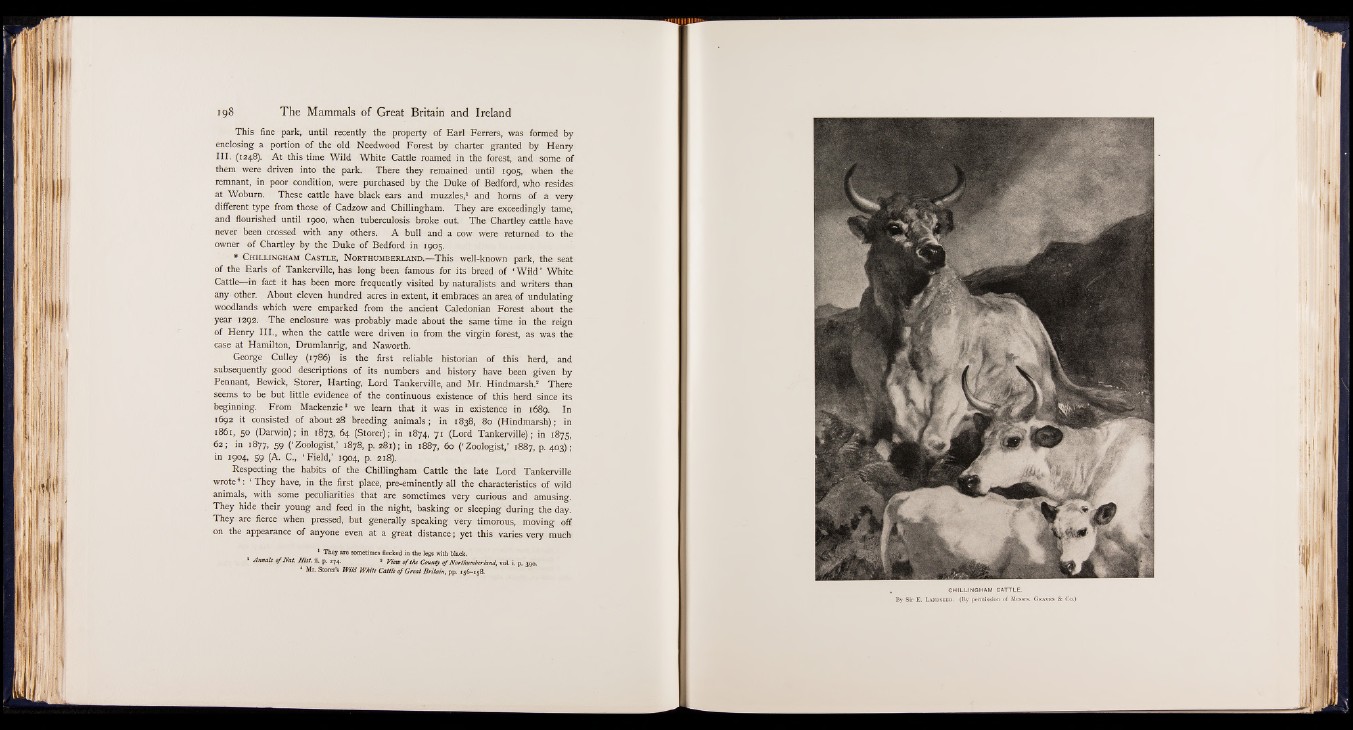
This fine park, until recently the property of Earl Ferrers, was formed by
enclosing a portion of the old Needwood Forest by charter granted by Henry
III. (1248). At this time Wild White Cattle roamed in the forest, and some of
them were driven into the park. There they remained until 1905, when the
remnant, in poor condition, were purchased by the Duke of Bedford, who resides
at Woburn. These cattle have black ears and muzzles,1 and horns of a very
different type from those of Cadzow and Chillingham. They are exceedingly tame,
and flourished until 1900, when tuberculosis broke out. The Chartley cattle have
never been crossed with any others. A bull and a cow were returned to the
owner of Chartley by the Duke of Bedford in 1905.
* C h i l l in g h a m C a s t l e , N o r t h u m b e r l a n d .— This well-known park, the seat
of the Earls of Tankerville, has long been famous for its breed of ‘ Wild ’ White
Cattle— in fact it has been more frequently visited by naturalists and writers than
any other. About eleven hundred acres in extent, it embraces an area of undulating
woodlands which were emparked from the ancient Caledonian Forest about the
year 1292. The enclosure was probably made about the same time in the reign
of Henry III., when the cattle were driven in from the virgin forest, as was the
case at Hamilton, Drumlanrig, and Naworth.
George Gulley (1786) is the first reliable historian of this herd, and
subsequently good descriptions of its numbers and history have been given by
Pennant, Bewick, Storer, Harting, Lord Tankerville, and Mr. Hindmarsh.2 There
seems to be but little evidence of the continuous existence of this herd since its
beginning. From Mackenzie8 we learn that it was in existence in 1689. In
1692 it consisted of about 28 breeding animals ; in 1838, 80 (Hindmarsh); in
1861, 50 (Darwin); in 1873, 64 (Storer); in 1874, 71 (Lord Tankerville); in 1875,
62; in 1877, 59 (‘ Zoologist,’ 1878, p. 281); in 1887, 60 (‘ Zoologist,’ 1887, P- 403);
in 1904, 59 (A. C., ‘ Field,’ 1904, p. 218).
Respecting the habits of the Chillingham Cattle the late Lord Tankerville
wrote4: ‘ They have, in the first place, pre-eminently all the characteristics of wild
animals, with some peculiarities that are sometimes very curious and amusing.
They hide their young and feed in the night, basking or sleeping during the day.
They are fierce when pressed, but generally speaking very timorous, moving off
on the appearance of anyone even at a great distance; yet this varies very much
1 They are sometimes flecked in the legs with black.
* Annals o f Nat. H ist. ii. p. 274. 3 View o f the County o f Northumberland, vol. i. p. 390.
* Mr. Store* Wild White Cattle o f Great Britain, pp. 156-158.